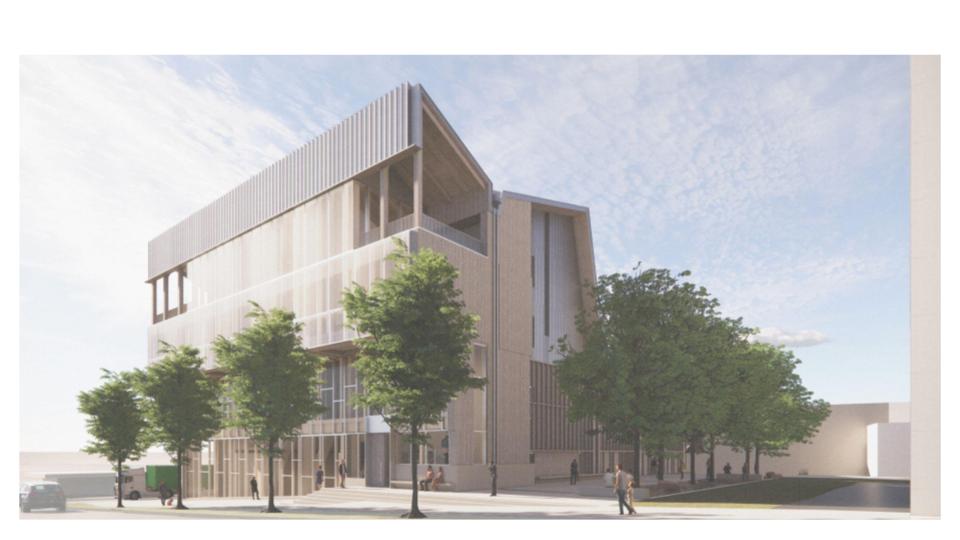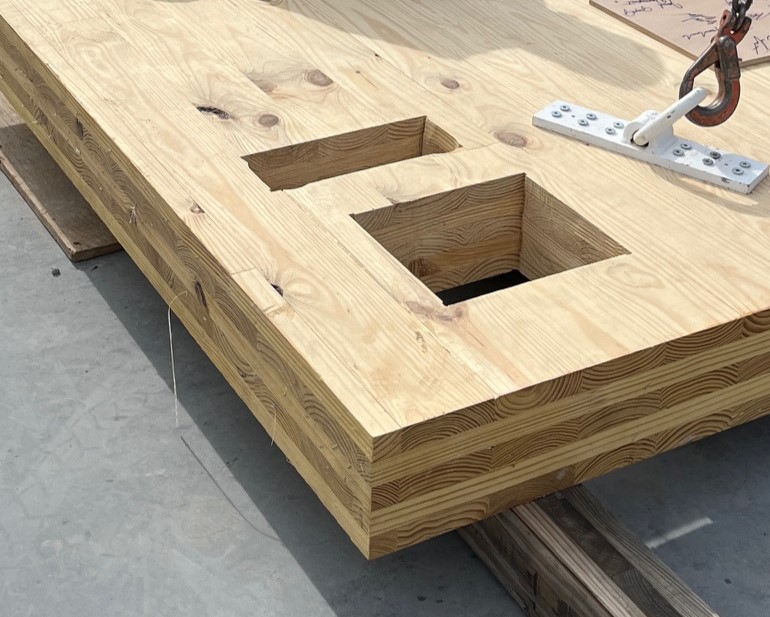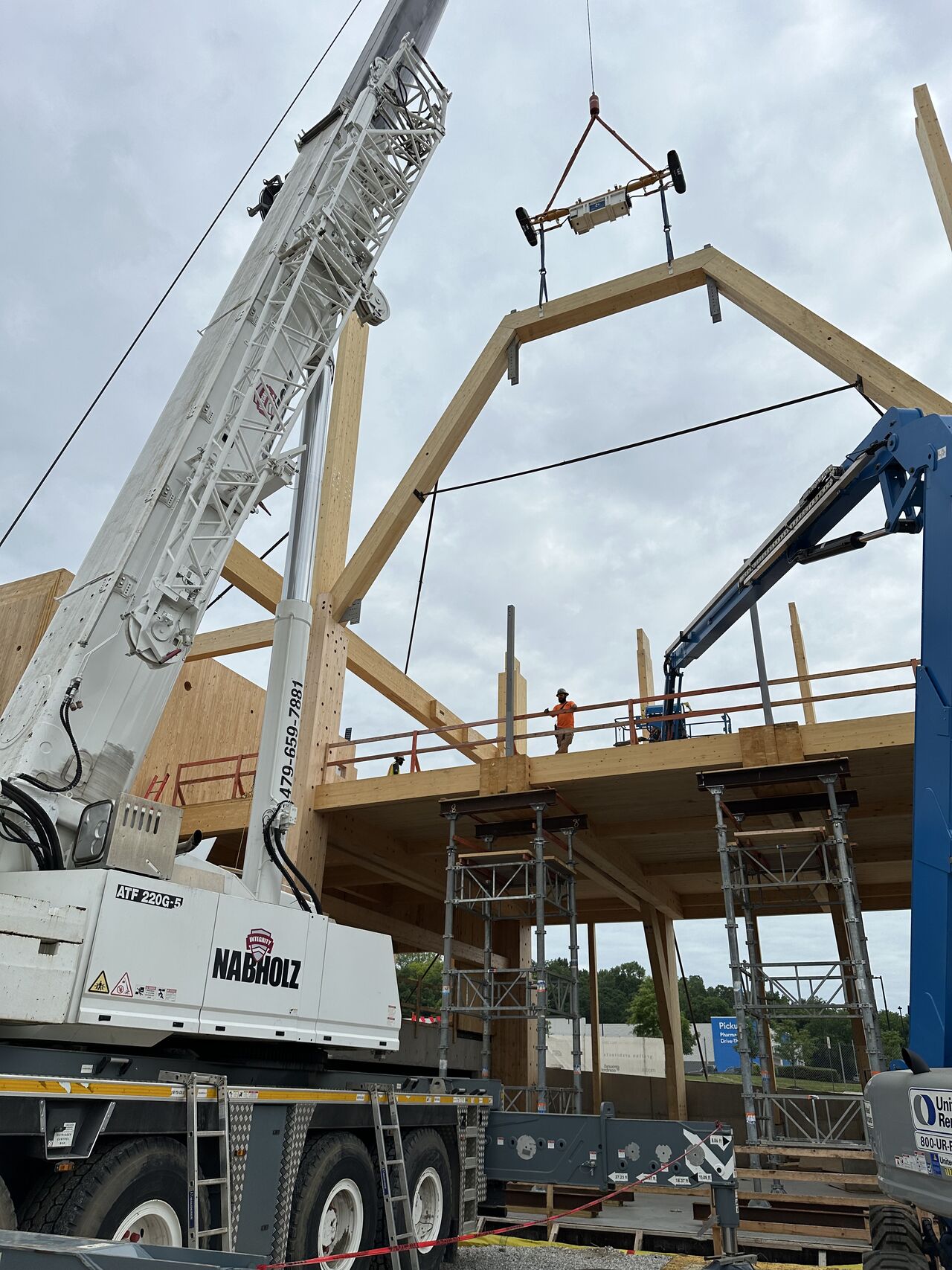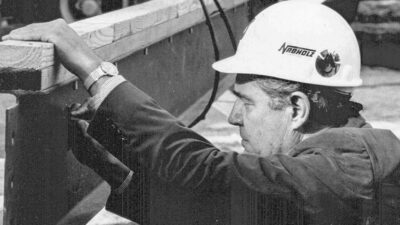In 2019, Nabholz completed the largest cross-laminated timber construction project in the U.S. at the time: Adohi Hall at the University of Arkansas in Fayetteville. Nabholz visited job sites around the country to learn about the material, develop a quality control program specific for mass timber, and train a team of craft workers to be master installers of the product.
Today, Nabholz partners once again with the university to construct Anthony Timberlands Center for Design & Materials Innovation, a new cross-laminated timber facility made almost entirely of mass timber. Construction began in fall 2023 and is expected to be completed in summer 2025 in time for the fall semester.

What is cross-laminated timber?
Cross-laminated timber, or CLT, is a relatively new construction method in the U.S. Popularized in Europe, the method fabricates plywood paneling off site in in a mill shop, where it is glued, pressed, and cut to size according to a project’s design specifications.

CLT consists of perpendicular layers of plywood glued on top of each other, in odd groups of three, five, or seven. Once glued, the timber is pressed together with a vacuum press or hydraulic press to form a solid panel, then cut to form door openings, window openings, ductwork chases, utility piping chases, and more. The finished panels are then transported to the job site where they are installed more quickly than traditional methods.
Building a facility out of CLT, instead of concrete or steel, has its advantages and disadvantages. CLT can be produced quickly, leading to faster project schedules with minimal errors in production. It also has a high char rate, meaning that in the case of a fire, it would burn slower and fail later than a steel structure would.
On the other hand, CLT has yet to gain an expansive library of building codes to ensure the material is installed correctly. This, combined with the high technical entry point for contractors, reduces the number of available experts to implement CLT. Research is being conducted by the USDA and others to establish more codes and encourage the use of more environmentally friendly material.
You can learn more about CLT and how Nabholz trained to be an expert in the material in our blog about Adohi Hall.
CLT in Arkansas
Cross-laminated timber is continuing to gain popularity in the United States as a construction material. Arkansas-based businesses and organizations, in particular, have been interested in pursuing CLT to utilize the state’s natural resources. In the past few years, Nabholz has worked on a variety of CLT projects, including Adohi Hall, 5th Street Offices in Bentonville, Nabholz’ own Rogers office, and more.
According to the Arkansas Economic Development Commission, Arkansas is covered by 19 million acres of forestland — that’s over half of the state’s total area. The timber industry has a huge impact on the state’s economy, with nearly 12% of its workforce employed in manufacturing and timber products sold to companies all over the world.
As CLT gains popularity, it can support Arkansas’ economy and other states with a large timber industry. More of Arkansas’ natural resources will be used, which will translate into more jobs to support the demand. It also means materials can be gathered locally instead of outsourcing and paying transportation costs to deliver them long distances.
Using CLT is also more environmentally friendly. Timber is a renewable resource that is replanted as it is cut down. Arkansas has a number of organizations dedicated to sustaining forests and ensuring trees are replanted after harvesting. In addition, the construction process for cross-laminated timber produces fewer carbon emissions than concrete or steel because fossil fuels are not burned during production.
Anthony Timberlands Center
The Anthony Timberlands Center is the University of Arkansas’ latest CLT project, with Nabholz on board as construction manager at-risk. The center is a $38 million project that will include a fabrication shop, studios, seminar and conference rooms, faculty offices, a small auditorium, and a public exhibition space for students of U of A’s timber and wood programs. The 44,800-square-foot building is designed by Dublin-based firm

Grafton Architects and local Fayetteville firm Modus Studio to be constructed (almost) entirely of mass timber.
This design choice makes Anthony Timberlands unique from the start. Typically, CLT projects utilize a
combination of CLT and structural steel. Anthony Timberlands has only a small portion constructed with steel beams and columns; the building’s elevator opening required structural steel to safely support the elevator’s load. The rest of the building is comprised of CLT and glued laminated timber — even the queen truss, which supports the load of an entire floor on its own.
The University of Arkansas selected southern yellow pine for approximately 60% of the project’s timber. The wood is native to Arkansas and was chosen as part of the university’s goal to utilize more of Arkansas’ natural resources in construction. Most of the pine was sourced from Arkansas, while 10% came from Washington. The remaining 40% of the project is constructed with spruce from Austria.
Nabholz has worked closely with contractors from all over the world to make the Anthony Timberlands Center a reality. Our team has coordinated with professionals from seven countries across six different time zones in order to construct the project’s complex design.
The project has already been recognized for its unique design by international publication The Architectural Review, which named the Anthony Timberlands Center overall winner of the magazine’s 2023 Future Project Awards, as well as winning first place in the new education category. The awards “celebrate excellence in unbuilt and incomplete projects, and the potential for positive contribution to communities, neighborhoods and urban landscapes around the world.” The center was the only North American project to be recognized.
The Future of CLT
Building codes are still catching up with what mass timber construction can do, informed by years of experience Europe already has with the material. Tests are also being conducted every day to update codes and help put cross-laminated timber into practice where it is most beneficial. In the coming years, CLT professionals expect to see the material used more often as owners turn to quicker and more environmentally friendly methods.
Nabholz continues to pursue CLT technology and projects to provide more tools for owners to choose from. Looking to learn more about CLT or work with Nabholz on your next project? Find out more here.

